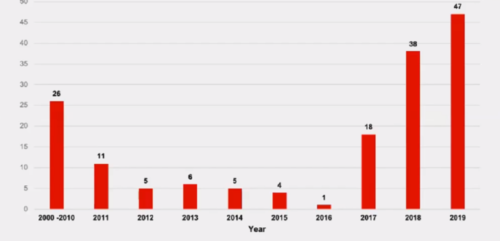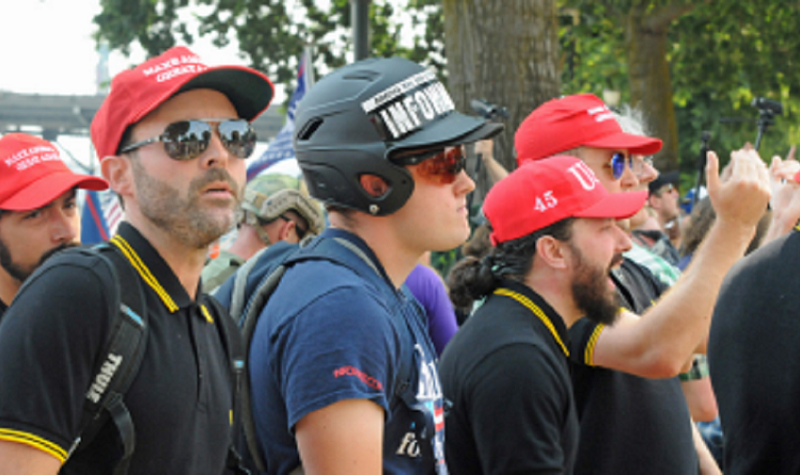NB Media Co-op and Société de L’Acadie du Nouveau-Brunswick hosted a panel titled “The Far-Right in New Brunswick: A Panel on Extremism and Exclusion,” on Feb. 23.
Brynn Trofimuk, a masters student of sociology at the University of New Brunswick, presented her research on the growing presence of far-right extremism in Atlantic Canada during the panel.
Her findings indicate that since 2016, the same year that former US President Donald Trump was elected, far-right activity has dramatically increased both in Atlantic Canada and around the world.
After Trofimuk examined incidents of extremism that took place in Atlantic Canada over the past 20 years, she found that around 65 per cent of all of those incidents took place after 2016.
Not only that, but the incidents are continuing to increase at an alarmingly high rate.

A graph shared by Brynn Trofimuk during her presentation, titled “Atlantic Canadian Incidents per Year.” (1/2)
“It’s really important to understand the context of right wing extremism currently in Canada, as well as globally,” said Trofimuk. “What researchers have found lately is an increase in right-wing extremism, particularly post 2016, and a shifting climate of right-wing extremism. Really, this is something that researchers don’t yet fully understand.”
“One of the things that we’re seeing concurrently with this rise in right-wing extremism is a growing normalization of hate,” she said. She references Donald Trump vilifying Islam, banning Muslim immigrants, and his promise to build a wall to keep Mexicans out of the United States.
Canadians are not exempt from the normalization of hate, says Trofimuk. She noted examples such as former Prime Minister Stephen Harper “viewing Islamization as the greatest threat to Canada” and former Conservative leadership candidate Kellie Leitch “attempting to screen [incoming immigrants] for Canadian values.”
Trofimuk’s research indicates that the types of far-right activity, as well as the frequency, is important to examine.
Rallies, gatherings, and recruitment activities have spiked in both New Brunswick and Nova Scotia.
“These fall along kind of four themes,” said Trofimuk in reference to protests and rallies. “Anti-immigration, anti-globalization, anti-Indigenous, as well as anti-government focused specifically on, or mostly on, Justin Trudeau.”

A graph shared by Brynn Trofimuk during her presentation, titled “Atlantic Canadian Incidents per Year.” (2/2)
New Brunswick has nearly 200,000 less people than Nova Scotia, but is not far behind when it comes to the rate of recent far-right activity.
Research reveals that Nova Scotia leads the Atlantic provinces with 74 incidents (over the course of the 20-year study period), but New Brunswick is close behind with 64 incidents.
“30 per cent of all incidents [in both New Brunswick and Nova Scotia] were property crimes. Mostly the property crimes that we were seeing were vandalism that was meant to intimidate a targeted group,” said Trofimuk. “Something like spray painting hate symbols, we saw that on a lot of churches, as well as on a few election signs.”
New Brunswick actually has a higher rate of far-right group meetings and protests than Nova Scotia, despite its lower population.
Trofimuk is looking into the rate of extremist activity based on language communities, because it appears that Anglophone communities have a higher rate of far-right activity.
“Right-wing extremism was predominantly taking place in English areas, more than 85 per cent… with a smaller amount in mixed areas, and only one of the incidents was located in French areas,” she explains. “Really, to fully understand why we’re seeing this, we would need to do more research. We can speculate that maybe it has something to do with cultural differences between French and English areas, potentially that there’s a stronger group identification among French Canadians. But it could also be that the English areas of the study are the more urban areas, so we’re seeing an urban effect. Or that of all the provinces, New Brunswick is the only bilingual province.”
Shayna Perry is also a masters student of sociology at UNB, and her research indicates a troubling link between far-right extremism and the Candian military.
There is, unquestionably, an overlap of far-right extremists and members of the Canadian military.
The extent of far-right involvement is still being investigated on a national level, but Perry said what has already been uncovered is enough to cause concern for domestic and international security.
“In a 2018 report, the Canadian military police criminal intelligence section identified 16 military members of extreme hate groups and 35 others engaged in racist or hateful behavior,” said Perry. “The numbers are likely higher, as extremist and extremist groups are known to go to great lengths to keep their association with extremism hidden.”
Perry found there to be a number of shared values between the Canadian military and members of far-right extremist groups, including hypermasculinity.
These values may appeal to those in far-right groups, who may join the military to gain combat and weapons expertise.
“Both the military and the right-wing extremist culture share common elements, such as hyper-masculinity, authoritarianism, or rigid hierarchy, and the need for brotherhood,” Perry explains. “Research demonstrates that it is this hyper-masculinity of both the military and the right wing extremist groups that link the two.”
Far-right extremist groups actively look to recruit members, or ex-members, of the military and police for their training and credibility.
The Proud Boys, a far-right extremist group recently added to Canada’s list of terrorist organizations, are an example of the intersection of a militarized far-right extremist group.
Perry said that the presence of far-right extremists in the military is a threat to public safety, and is still being uncovered.
“Right-wing extremism is an issue in the Canadian Armed Forces, and if not dealt with can pose a serious threat to Canadian public safety,” warns Perry. “If these extremist groups continue to radicalize and recruit members of the armed forces, there is a risk that these military recruits will disseminate their military training and to these groups and increase the group’s credibility and lethality.”
The link between the Canadian military and far-right groups is “a complicated and nuanced issue,” but Perry is optimistic that the military’s Hateful Conduct Policy is a “correct step toward combating the issue.”
Associate Professor of Sociology at UNB, David Hofmann, said he is often asked what can be done about this growing presence of right extremism.
The answer to that question, he said, is still being developed.
“We’re beginning to acknowledge this problem. We’re late to the game to be honest…the Canadian government only recently started funding research on right-wing extremism,” said Hofmann. “We are late to the game, but what can we do as Canadians to confront this type of hate? These types of groups that are a threat to our very the Canadian way of life?…It takes grassroots organizations, people like you, people who are interested, and people who take the time to inform themselves, to engage in dialogue, to stand up and confront these types of groups, these types of ideologies, in a peaceful way.”
Hear this story as reported by CHMA:


